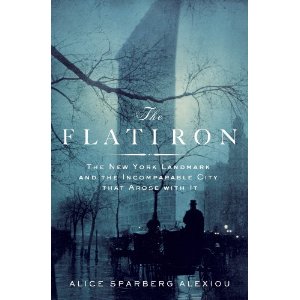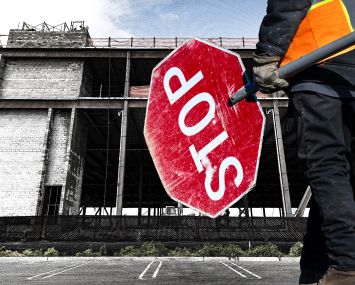 Skyscrapers make the best metaphors. Whether fortress or phallus, they offer the urban writer an unparalleled literary device for capturing the audacity and arrogance of the people who build and finance them. They’re not half-bad for synecdoche, either, standing in for whole American cities in more than a few popular histories. In her new book The Flatiron: The New York Landmark and the Incomparable City That Arose With It, Alice Spareberg Alexiou strives, as the mouthful of a subtitle indicates, to accomplish both of these things, to capture the spirit of the freewheeling financiers who built the pride of Madison Square and, in the process, to tell the story of all New York at the turn of the last century.
Skyscrapers make the best metaphors. Whether fortress or phallus, they offer the urban writer an unparalleled literary device for capturing the audacity and arrogance of the people who build and finance them. They’re not half-bad for synecdoche, either, standing in for whole American cities in more than a few popular histories. In her new book The Flatiron: The New York Landmark and the Incomparable City That Arose With It, Alice Spareberg Alexiou strives, as the mouthful of a subtitle indicates, to accomplish both of these things, to capture the spirit of the freewheeling financiers who built the pride of Madison Square and, in the process, to tell the story of all New York at the turn of the last century.
Such an endeavor, upon which a young David McCullough would have lavished at least 700 pages, is well nigh impossible in this quick, slim volume, and that’s for the best, as it’s unclear that the Flatiron is really up to the task of carrying so broad a load on its narrow shoulders. There are plenty of classic urban-historian touches—the thick descriptions of the bold new technology used to erect the mighty structure, the gritty tableaus of tenement life juxtaposed with the formal photos of wealthy, mustachioed men in top hats—but in place of a grand narrative building to an inevitable climax, The Flatiron offers the loosely connected stories of scores of individuals and events with its triangular protagonist at their swirling center. Think of it as Alejandro González Iñárritu does Beaux-Arts.
Ms. Alexiou opens with a bit of personal history: Her grandfather, a “quintessential New York story, the immigrant who came from nothing and made good,” joined Harry Helmsley in purchasing the Flatiron in 1946, and the building remained in her family for 50 years. To her, she writes, “this building embodies the very essence of our city,” and while the Flatiron may not be the obvious embodiment of the city for most New Yorkers, her passion drives a rich quest for the stories of other men who saw the building as a peak upon which to plant their flag.
Most notable of these is the Flatiron’s builder, Harry St. Francis Black, whose biographical details occupy, in fits, starts and second glances, somewhere between one-third and one-half of the book. A Horatio Alger story in his own right (as a delicious aside, Ms. Alexiou notes that Horatio Alger’s stories themselves were published out of the Flatiron), Black was a prototypical property-hungry developer, self-made man and lover of the deal who Ms. Alexiou compares to Helmsley and to Donald Trump (as well as to her own family patriarch). The Flatiron was built to house Black’s “skyscraper trust,” United States Realty and Construction, and he built his company alongside it, acquiring the contracts for Macy’s, Pennsylvania Station and the Plaza Hotel, among others. It is in comparing Black and his headquarters that Ms. Alexiou’s proposed metaphor works best: Both man and skyscraper were bold, controversial, scorned by establishment thinking and interesting to nearly everyone who crossed their paths.
The remainder of The Flatiron is a series of snapshots, a scrapbook of the individuals, inventions and ideas whose paths crossed at 23rd Street, Fifth Avenue and Broadway. We encounter silent-movie makers, jazz stars, restaurateurs, publishers, cubist painters and Tammany politicians, whose appearances are not so much woven into a single story as left to branch out from their terra-cotta trunk. This approach offers innumerable fascinating tidbits about the building and the era—the stories of near-riots over pay-to-sit chairs in Madison Square Park and water shooting from every floor of the Flatiron as its standpipe was tested are particularly fun—all of which contribute to a free-flowing tableau, one in which, Ms. Alexiou writes, “change was the essence of New York.”
The size of the ensemble cast grows unwieldy at times, particularly as we delve deeply and distractingly into the minutia of Harry Black’s personal life, and Ms. Alexiou’s occasional speculation as to characters’ emotions or actions feels forced and lacks the in-the-moment oomph that such creative license should evoke if used in writing history. The snapshot approach is necessarily hit-or-miss, leaving some tales under-told or swinging unconnected in the breeze.
In the end, however, it suits this book, and this landmark, which is, as it ever was, a strange creation, “different from every angle,” as Alexiou reminds us, and suggesting comparisons to everything from an ocean liner to a slice of cake (or even a household appliance). While this may not be the iconic, triumphant book about the triumphant icon that she set out to write, it is a suitable companion for a New York summer, a reminder of the myriad stories and strange bedfellows that spin their way through the streets, bumping up against one another and striving for attention and success, often at any price.
Though she ends on a note of permanence, as the landmarked and restored Flatiron is here to stay, Ms. Alexiou’s book is ultimately about the never-ending change that rushes by in the city, and, in evoking that, she succeeds.
Nick Juravich holds degrees in history from the universities of Chicago and Oxford, and blogs about neighborhood change in New York at I Love Franklin Ave.
PREVIOUSLY > How Communism Shaped New York—Literally


